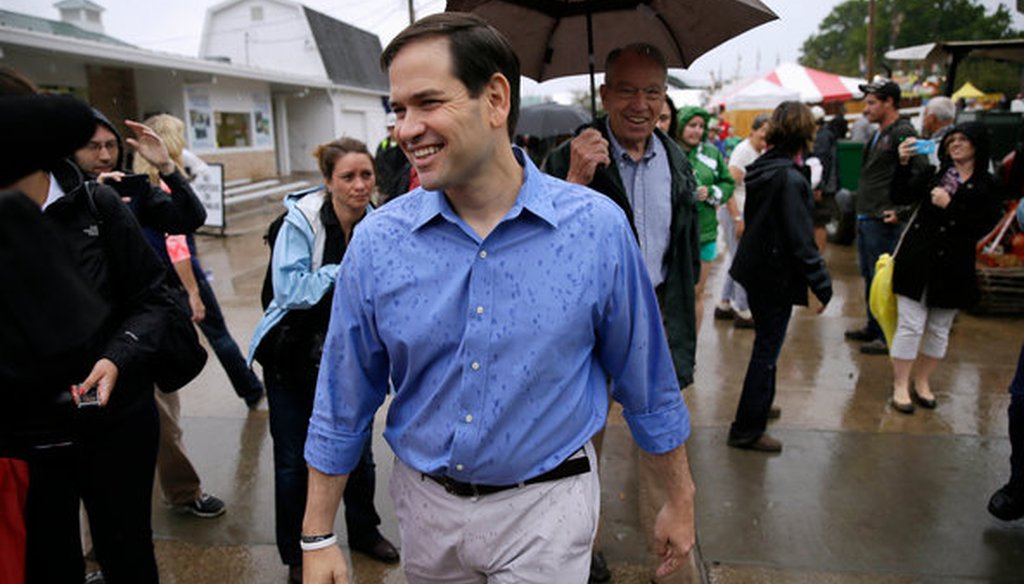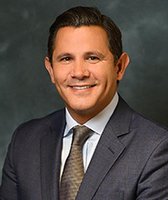Stand up for the facts!
Our only agenda is to publish the truth so you can be an informed participant in democracy.
We need your help.
I would like to contribute

U.S. Sen. Marco Rubio campaigned at the Iowa State Fair on Aug. 18, 2015. (Associated Press photo)
Marco Rubio says the Army just cut 40,000 spots
U.S. Sen. Marco Rubio, R-Fla., said at the Iowa State Fair that to face threats from across the globe, ranging from the Middle East to Asia to Russia, the United States needs to keep its military strong.
"The most important obligation of the federal government is to keep you safe and me safe and our family safe," Rubio said on Aug. 18, 2015. "And it’s not doing that now, because we are eviscerating our defense spending."
One example he cited: "We have an Army that just cut 40,000 spots."
We were curious if that number was correct, so we decided to check it out.
Army announcement
Army officials had been talking about reducing the size of their force for several months when they announced specific plans in July 2015. The Army said it will cut the size of the regular Army from 490,000 to 450,000 by fiscal year 2018 -- that’s 40,000 -- with some of the largest cuts at sites in Georgia and Texas. Those cuts will start in October 2015 and end by October 2018. That means the cuts to the Army haven’t happened yet and will be finished under the next president.
The cuts are expected to come through attrition, early retirements and layoffs. That’s in addition to plans to cut 17,000 civilians.
The Army has been substantially scaling back its force the past few years. In 2012, the Army had about 570,000 soldiers. In 2013, the Army announced a drawdown of 80,000 to bring the size to the current 490,000. The new cuts will save about $7 billion.
Army officials said the cuts are a result of the Budget Control Act of 2011 and the budget sequestration that followed. If sequestration continues, the Army expects to shrink to about 420,000 soldiers sometime in 2019.
"We think 450,000 is the minimum force to meet our obligations across the globe," Army spokesman Lt. Cmd. Joe Buccino told PolitiFact.
Some lawmakers have questioned the cuts in light of the current situation with the Islamic State in Iraq and Syria, among other crises. In an op-ed in the Washington Post in May, Rubio was critical of Obama’s actions in Iraq and Syria. He called for the president to "increase the number of U.S. forces in Iraq."
Rubio correctly cited the number that the Army plans to cut, but he omitted some caveats, including that the cuts haven’t taken place yet. And it’s difficult to predict if the cuts will be fully implemented as the end date in 2018 will be under a new president and Congress.
Featured Fact-check
"The reduction in active Army end-strength is likely but far from certain, given that lots of people in the Congress would like to get the Army more money," said Benjamin Friedman, a military expert at the libertarian Cato Institute.
Mackenzie Eaglen, a defense expert at the conservative American Enterprise Institute, said she expects the cuts to occur.
"The Army waited as long as possible to even start this latest reduction in force size," she said.
While the talking about the reduction in soldiers makes good political fodder, it doesn’t address whether higher troop counts are needed, said Charles Knight, co-founder of Project on Defense Alternatives, a group that advocates for lower levels of armed force and military spending worldwide.
"The only circumstance in which the Army needs those soldiers is if the U.S. were to reoccupy Iraq, invade and occupy Syria or Iran, or such," he said. "Current government policy is explicitly against such options."
But the next president -- whether it’s Rubio or someone else -- "could easily reverse current policy starting in 2017," Knight said.
A few experts took issue with Rubio’s statement that we are "eviscerating" defense spending.
"The term eviscerate is, to my mind, entirely unwarranted for a military that continues to spend almost $600 billion a year, well above the Cold War average and nearly 40 percent of the world’s total," said Michael O’Hanlon, a defense expert at the Brookings Institution.
Our ruling
Rubio said, "We have an Army that just cut 40,000 spots."
Rubio was referring to an announcement by the Army in July that it will cut 40,000 spots by fiscal year 2018. Those cuts had been talked about for several months, but the specifics were released in July.
The cuts will start this fall but are expected to continue under the next president. Since the end date is under a new president and Congress, it’s difficult to guess if they will all happen, but that’s the plan for now.
We rate this claim Mostly True.
Our Sources
C-SPAN, Sen. Marco Rubio at the Des Moines Register presidential soapbox, Aug. 18, 2015
U.S. Army press release, "Army to realign brigades, cut 40,000 soldiers, 17,000 civilians," July 9, 2015
Armed Services Committee, Letters from Secretary of Defense Leon Panetta to Sen. John McCain and Sen. Lindsey Graham, Nov. 14, 2011
Washington Post, "Army details how it will cut to its smallest size since World War II," July 9, 2015
Washington Post op-ed by Sen. Marco Rubio, "Obama’s strategy for the Middle East has backfired," May 29, 2015
Army Times, "Army lays out plans to cut 40,000 soldiers," July 10, 2015
The National Interest, "Is America’s Air Force dying?" May 7, 2014
PolitiFact, "Jeb Bush says Democrats ‘responsible’ for ‘swift, mindless’ cuts to defense spending," June 22, 2015
PolitiFact, "Defense spending has dropped 21 percent since 2010 Rubio says," March 30, 2015
Interview, LTC Joe Buccino, U.S. Army spokesman, Aug. 19, 2015
Interview, Richard Kohn, University of North Carolina Professor Emeritus (History and Peace, War, and Defense), Aug. 19, 2015
Interview, Michael O’Hanlon, Brookings Institution senior fellow, Aug. 19, 2015
Interview, Charles Knight, Project on Defense Alternatives senior fellow, Aug. 19, 2015
Interview, Benjamin Friedman, CATO Institute research fellow, Aug. 19, 2015
Interview, Mackenzie Eaglen, resident fellow in the Marilyn Ware Center for Security Studies at the American Enterprise Institute, Aug. 20, 2015
Interview, Alex Conant, U.S. Sen. Marco Rubio spokesman, Aug. 19, 2015
Interview, Brooke Sammon, U.S. Sen. Marco Rubio spokeswoman, Aug. 19, 2015
Browse the Truth-O-Meter
More by Amy Sherman
Marco Rubio says the Army just cut 40,000 spots
Support independent fact-checking.
Become a member!
In a world of wild talk and fake news, help us stand up for the facts.








































